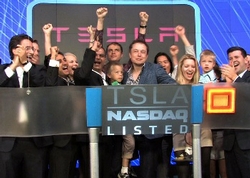Andrew Rossi’s documentary “Page One: Inside the New York Times” examines the world’s most famous newspaper. Photos courtesy of AFI Discovery/Silverdocs.
Page One: Inside the New York Times
Venerated media institution? Check. Complex, charismatic antihero? Check. Compelling subject? Check. Focused narrative? Not so much. It’s hard to imagine that filmmaker Andrew Rossi wasn’t thinking of R.J. Cutler’s The September Issue and the show-stealing qualities of Grace Coddington when he embarked upon editing his new documentary, Page One: Inside the New York Times. It’s also hard not to imagine that Rossi’s project was an entirely different movie before he stumbled upon the gravelly voiced presence of David Carr, and got sucked into the vortex of Carr’s unlikely magnetism.
For Rossi, who surely discovered early on that as fascinating a subject as the Times is, the intricacies of a bunch of people essentially sitting around desks and working doesn’t generally make for enthralling viewing, Carr made for an irresistible focus. He’s a media figure writing about how media covers media, which must be one of the most meta jobs in the world, but he’s also a recovering crack addict, spent time as a single father on welfare, and is a former editor of Washington City Paper. As Rossi ably shows, Carr is first and foremost a legendary reporter and writer, not to mention a staunch defender of the Times in the face of naysayers like Jeff Jarvis, Michael Wolff, and some of the black-hat-wearing cool kids from Vice magazine.
All that said, Rossi’s film isn’t about Carr. It’s intended to be a detailed look at the intricacies of the world’s most famous newspaper, but you can’t help thinking any reasonable Times editor would take one look at it and wonder where the nut graf was. Scattered, vague elements of various stories (Wikileaks, scandals at the Tribune company, the Times’ survival as a business) are clumsily interspersed with clips of everyone from Gay Talese to Gawker’s Nick Denton. It’s interesting, but you’re not quite sure what it all means.
Still, there are a number of fascinating nuggets of insight into the workings of the Gray Lady here. One: Brian Stelter types all his interviews in Gmail. Two: Everyone at the Times seems to smoke. And three: Only people as powerful as Bill Keller can talk as quietly as he does in meetings.
Page One: Inside the New York Times screens at AFI Silver 1 at 5:15 PM on Wednesday, June 22. Individual tickets and festival passes (prices vary) available through the Silverdocs Web site. (And if you miss it at Silverdocs, it’s opening at Landmark’s E Street on July 1.)

Bob and the Monster
We’ve seen the rock-and-roll, drugs, and recovery movie before, but director Keirda Bahruth injects (literally) new life into the genre in Bob and the Monster, the tale of musician Bob Forrest’s addiction, recovery, and reinvention as a “punk-rock recovery” counselor. Combining interviews and animated sequences with an apparent treasure trove of archival footage, Bahruth manages to make a compelling case for sobriety while pulling no punches on exactly how high the highs and how low the lows can so often be.
Before Forrest was a pockmarked, charismatic addiction counselor famous for his appearances on Celebrity Rehab With Dr. Drew, he was the frontman for Thelonious Monster, a punk outfit that almost made it big-big-time in the 1980s but was eclipsed by the success of fellow LA bands like Red Hot Chili Peppers, Jane’s Addiction, and Fishbone. “Bob’s life is an amazingly perfect story,” says Fishbone’s Norwood Fisher at the beginning of the movie—and so it seems, as long as your definition of “perfect” is fairly fluid. Forrest was born to a seemingly staid middle-class Palm Springs family in 1961, and his life became unexpectedly complicated when his parents revealed that his older sister was actually his mother. Bahruth includes snapshots of a young Forrest in the movie; his anguish is heartbreaking.
Forrest’s ascent to music stardom and descent into heroin and crack addiction is watchable stuff, particularly the animated sequences of his first encounter with Dr. Drew on a 1980s radio show (“I think there’s a career here for you, Bob,” the talk host said—presciently, as it turned out). Scenes of Forrest absolutely out of his tree while performing can get a little tedious, but they seem to be an important part of the narrative. More graphic, and visually horrifying, is a scene depicting RHCP’s John Frusciante giving an interview in the depths of his addiction; Frusciante, who was almost a member of Thelonious Monster, was one of Forrest’s first success stories as a rehab counselor. It’s a moment of insight into what blistering, searing ugliness addiction is, as is a claymation sequence depicting one of Forrest’s lowest points.
Bahruth intersperses the film with interviews with Forrest’s fellow musicians (and addicts): Anthony Kiedis, Courtney Love, Flea, Steven Adler, and a cleaned-up Frusciante, all of whom pay testament to how awful he used to be and how magnificent he is now. “He’s given up his life for the twelfth step,” says Love in a surprisingly lucid interview. Sobriety, Forrest says, “is a very simple life,” and you get the sense he’s found his true calling after a long period of ups and downs, not to mention having finally beaten the monster.
Bob and The Monster screens at the Discovery HD Theater at 1:15 PM on Tuesday, June 21, and AFI Silver Theater 3 at 6:15 PM on Saturday, June 25. Individual tickets and festival passes (prices vary) are available through the Silverdocs Web site.

Revenge of the Electric Car
Note to President Barack Obama and anyone else currently worrying about the state of the environment: Filmmaker Chris Paine has some insight for you. It turns out all you have to do to make greenness palatable is to wrap it up in a big pile of money and tie it up with a bigger, check-shaped ribbon. Bingo. All your grumpy corporate naysayers will be investing in environmentally friendly technology before you can say “Nissan Leaf.”
It sounds simplistic, but this is the take-home message from Revenge of the Electric Car, filmmaker Chris Paine’s follow-up to his 2006 documentary, Who Killed the Electric Car?, which saw General Motors’s destroying all 5,000 cars in its EV1 range. At the time, it seemed as if all hope for gasoline-free vehicles was gone. Revenge opens a couple of years later, as four very different people are revisiting the concept: GM’s Bob Lutz, Nissan/Renault’s Carlos Ghosn, Tesla wunderkind and PayPal entrepreneur Elon Musk, and Greg “Gadget” Abbott, a California inventor who converts classic cars to run on electricity.
There’s a real cast of characters for Paine to work with here. Lutz is a comically old-fashioned businessman, the kind who plays golf and smokes cigars and says things like, “I do consider myself an environmentalist, but within reason,” while standing in front of a Hummer. Ghosn, the man behind the first affordable electric car, the Nissan Leaf, looks like a cross between a Bond villain and Hercule Poirot (you sense he has the ability to make people tremble with fear by fractionally raising an eyebrow). Musk is actually the real-life inspiration behind Robert Downey Jr.’s portrayal of Iron Man Tony Stark, with his successful space travel business and squillions of dollars. And Gadget works out of a Los Angeles lot and sports a comical mustache, but has the ability to make electric cars out of achingly beautiful classic models.
Whatever compelled GM to abandon the electric car, it’s clear that greenbacks are the inspiration for its renewed interest, with gasoline tipping over $4 a gallon and Musk’s sporty new Tesla nipping at Lutz’s heels. Paine’s analysis of the auto industry is sharp and nuanced, even as he appears briefly in person to shrug off the news that his own Tesla is going to cost more than expected (how do you spell conflict of interest?). The financial crisis strikes in the middle of the movie, bringing unprecedented complications and death knells for GM, which is all but lost until another unconventional superhero steps in. But ultimately, the success and resilience of all four carmakers seems to be a tribute to their gutsiness (as well as to the enduring nature of capitalism. It’s no coincidence that Musk’s savior comes in the form of the New York Stock Exchange).
Paine includes an obligatory roster of celebrities, from Danny DeVito to Anthony Kiedis to Adrian Grenier. But my favorite celebrity cameo comes from Arnold Schwarzenegger, who looks at a Tesla and tells Musk, “It would be the perfect thing for Maria.” He may want to rethink the wisdom of giving his angry, soon-to-be-ex-wife a silent vehicle.
Revenge of the Electric Car screens in AFI Silver 1 at 7:30 PM on Saturday, June 25, and 4:15 PM on Sunday, June 26. Individual tickets and festival passes (prices vary) are available through the Silverdocs Web site.
Subscribe to Washingtonian
Follow Washingtonian on Twitter
More>> After Hours Blog | Arts & Events | Happy Hour Finder | Calendar of Events
















